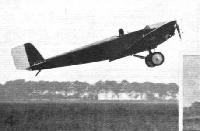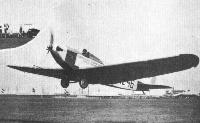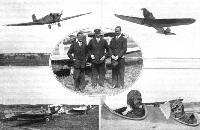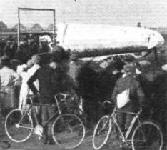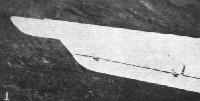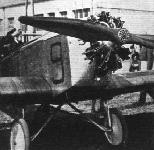
Варианты
- Daimler - L 20 - 1924 - Германия
- Klemm - L.25 - L.28 Swallow - 1927 - Германия
- British Klemm - L.25 Swallow - 1933 - Великобритания
Flight, May 1925
THE ROUND-GERMANY FLIGHT
THE MACHINES
Daimler-Motoren-Gesellshaft.
One of the most famous names, not only in German automobile and aviation circles, but in the world, is that of Daimler. The machines taking part in the Round-Germany flight were designed and built by the Sindelnngen works of the Daimler Motor Co., which have been interested in light 'plane construction for some considerable time. Two very interesting types are entered (some in several examples) for the competition, these being the L.20 and L.21. Unfortunately, photographs are available of the former only. We say unfortunately, because the L.21 machines entered are, according to the entries list, to be fitted with two engines each. As each of these Mercedes engines is only rated at 19 h.p., it will be seen that, in spite of being twin-engined machines, the L.21 may fairly be described as a light 'plane. This is of course a very interesting innovation, and it will be curious to see how the twin-engined type compares for reliability with the single engined.
The L.20 may be said to be a development of the L.15 light 'plane which was described in FLIGHT some months ago. A novel feature of the design is that the machine has been so arranged as to be suitable for use both as a light 'plane and a glider. When it is desired to use the L.20 as a glider, an ingenious arrangement enables the wings to be swept back at a considerable angle so as to bring back the c.p. The engine is removed and a nose-cap fitted over the front of the fuselage. With this arrangement the absence of the engine in front is balanced by the backward sweep of the wings and the machine retains its trim fore and aft.
Constructionally, the Daimler L.20 follows orthodox lines. The wing is placed low on the fuselage, and is of the cantilever type. The wings are attached to short wing roots built into the fuselage, and can be easily dismantled for transport, when they fold fiat against the sides of the body. The fuselage is of ordinary girder type and fabric covered. The undercarriage is divided so as' to minimise the risk of the machine tripping up in long grass.
This 'plane has a Mercedes engine specially developed for use on light 'planes. It is of the two-cylinder opposed air-cooled type with a bore of 75 mm. and a stroke of 100 mm., giving a cubic capacity of 885 c.c. The wing area of the L.20 is 20 sq. m. (215 sq. ft.) and the empty weight is 220 kg. (485 lbs.), with a useful load of 170 kg. (375 lbs), the total loaded weight being 390 kg. (860 lbs.). The top speed is stated to be 100 km./h. (62 m.p.h.) and the landing speed 60 km./h. (37 1/2 m.p.h.), the ceiling (which has actually been reached in flight) is 3,500 m. (11,500 ft.).
- Flight, May 1925
THE ROUND-GERMANY FLIGHT
Фотографии
-
Flight 1926-05 / Flight
The Daimler L.20 on which the flight over the Alps was accomplished. The engine is a Mercedes-Daimler of 19 h.p. only.
-
Flight 1929-03 / Flight Advertisements
Baron Friedrich-Karl Freiherr von Koenig Warthauser and the 20 h.p. Klemm-Daimler baby plane in which he made his record flight from Berlin to Karachi, and in which he won the Hindenburg Cup for the best amateur light plane in Germany. After this award the Baron wrote "Allow me to congratulate you once again on your famous CASTROL Oil which I use exclusively in my monoplane."
-
Flight 1925-05 / Flight
The Daimler L.20 is a low-wing light monoplane two-seater with 19 h.p. Mercedes-Daimler engine.
-
Flight 1928-09 / Flight
TAKING OFF AT ORLY: (4) The Klemm (Salmson) flown by Herr Lusser.
-
Flight 1928-07 / Flight
AT THE ROTTERDAM LIGHT 'PLANE MEETING: The take-off and landing competition. 5. The little Klemm-Daimler "zooms."
-
Flight 1927-09 / Flight
The Zurich Meeting: An aerial view of the little Klemm-Daimler monoplane, the lowest-powered machine at the meeting (20 h.p.).
-
Flight 1926-05 / Flight
Not very inviting in case of forced landings. Looking out over the port wing at the Hohe Tauern mountains.
-
Flight 1926-05 / Flight
OVER THE ALPS IN A 19 H.P. TWO-SEATER: These photographs give an excellent idea of the difficult country over which the little Daimler L.20 had to fly. In 1, the machine it seen approaching the Zeller See. 2 shows, on the left the Hohe Docke and, in the back-ground, the Glocknerin. The tip of the tail plane may just be seen on the right of the picture. The Hohe Tauern mountain chain is seen in 3, while 4 shows the two aviators, Dr. von Langsdorff (left) and Herr Guritzer the pilot, on their return to Sindelfingen.
-
Flight 1926-05 / Flight
Регистрационный номер: D-818 ON THE ZELLER SEE: After a successful landing on the ice.
-
Flight 1927-07 / Flight
GERMAN LIGHT 'PLANES VISIT ENGLAND: These photographs show the Klemm-Daimler L.20 machines on the ground and in flight. In the lower right-hand corner Lady Bailey is seen at the start of a flight with Herr Lusser. In the centre the three German pilots who visited this country. They are, from left to right, Herr Lusser, Herr Siebel, and Herr Lorzer.
-
Flight 1928-09 / Flight
SUCCESSFUL COMPETITORS IN THE 1928 ORLY MEETING: Herr R. Lusser (left) won with 1,691 points on the Klemm (Salmson) machine shown above him. Capt. E. W. Percival (centre) was second with 1,606 points on the Avro "Avian" (Cirrus Mk. III) (above); and Capt. H. Broad (right) third with 1,581 points on the Gipsy-Moth (above).
Другие самолёты на фотографии: Avro Avian / Type 594/616 - Великобритания - 1926De Havilland Gipsy Moth / Moth X - Великобритания - 1928
-
Flight 1926-05 / Flight
TRANSPORT BY ROAD: This photograph shows how the Daimler L.20 is towed by a motor car, the wings being dismantled and hung on the sides of the fuselage.
-
Flight 1928-09 / Flight
FOLDING TESTS AT ORLY: Our machines showed superiority in the folding tests at the French Light 'Plane Trials. (3) The Klemm-Daimler
-
Flight 1925-06 / Flight
IN THE ROUND-GERMANY FLIGHT: The combined trailing edge and wing-tip flap on the single-engined Mercedes-Daimler L.20.
-
Flight 1925-06 / Flight
SOME OF THE ENGINES IN THE ROUND-GERMANY COMPETITION. The Mercedes Daimler in the L.20. Note the steel tube mounting.
-
Flight 1928-09 / Flight
Showing the Salmson 40 h.p. engine in the Klemm-monoplane, which has brought Herr Lusser provisionally top of the competition.
-
Flight 1928-07 / Flight
VARIOUS WAYS OF USING RUBBER SHOCK ABSORBERS: 1, on the little Klemm-Daimler.
- Фотографии



